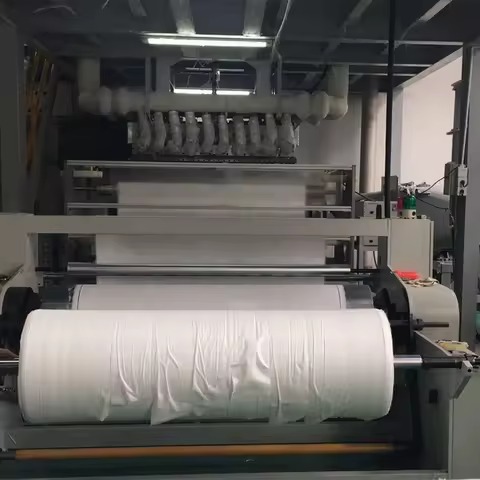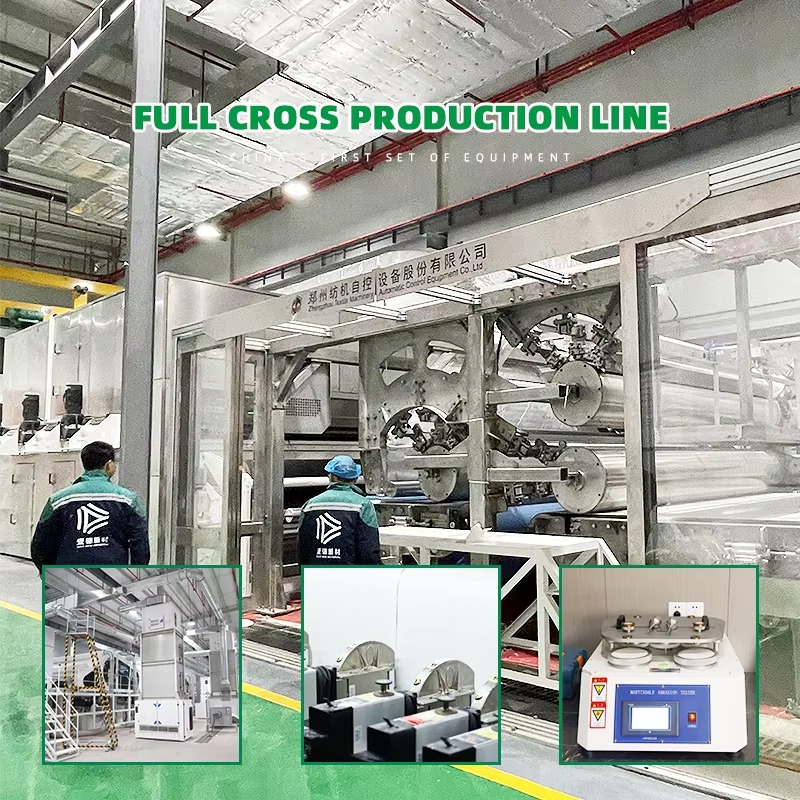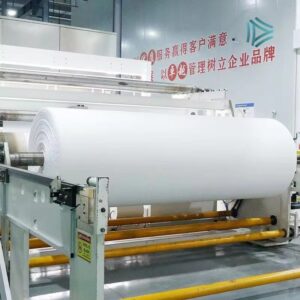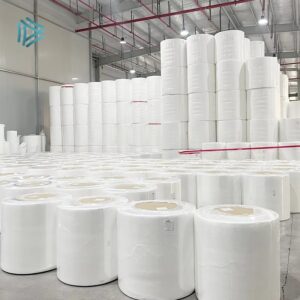Material Innovation & Future Trends in Spunlace Nonwoven Fabric
Introduction
Textiles have always been central to human progress, but the expectations placed on fabrics in the 21st century go far beyond appearance or basic functionality. Today, materials must deliver performance, safety, comfort, and sustainability—all while being adaptable to fast-changing global needs.
Among modern nonwoven fabrics, Spunlace has emerged as a frontrunner thanks to its unique hydroentanglement process and versatility. Already used in healthcare, hygiene, automotive, household, and agricultural applications, spunlace is now evolving further through material innovations and future-ready technologies.
This article explores the next frontier of spunlace nonwoven fabrics, focusing on new raw materials, advanced fiber technologies, intelligent manufacturing, and sustainable production that are shaping the future of this transformative textile.
1. The Role of Raw Materials in Spunlace Performance
The choice of raw materials directly influences the softness, absorbency, strength, durability, and sustainability of spunlace fabrics. Manufacturers today are experimenting with a wide range of fibers to achieve specific performance goals.
1.1 Natural Fibers
Cotton: Highly absorbent, soft, and biodegradable, making it ideal for wipes and hygiene products.
Bamboo Fiber: Naturally antibacterial, moisture-wicking, and eco-friendly.
Wood Pulp: Cost-effective, renewable, and biodegradable, widely used in wipes and tissue-like products.
Linen & Hemp: Durable and naturally breathable, increasingly used in eco-conscious textiles.
1.2 Regenerated Fibers
Viscose/Rayon: Soft, absorbent, and biodegradable, commonly blended with synthetics for balance.
Lyocell/Tencel®: Produced with closed-loop technology, offering high eco-performance.
Chitosan Fiber: Derived from natural chitin, with antimicrobial and biodegradable properties.
1.3 Synthetic Fibers
Polyester (PET): Provides strength, wrinkle resistance, and durability.
Polypropylene (PP): Lightweight, water-resistant, and cost-effective.
Nylon (PA): Adds resilience and abrasion resistance.
Low-Melting-Point Fibers: Used for thermal bonding and structural reinforcement.
1.4 Blended Fibers
Blends such as viscose/polyester (70/30) combine the absorbency of natural fibers with the durability of synthetics. This balance allows customization for specific industries like medical, cleaning, or packaging.
2. Advanced Fiber Technologies
Beyond traditional raw materials, researchers are developing next-generation fibers to enhance spunlace performance.
2.1 Nanofibers
Nanofibers, with diameters in the nanometer scale, significantly increase the surface area-to-volume ratio of fabrics. This leads to:
Superior filtration efficiency (used in masks, HVAC filters, and water purification).
Improved moisture management in hygiene and sportswear.
Enhanced antibacterial properties when combined with functional coatings.
2.2 Bio-Based & Biodegradable Fibers
To reduce dependence on petrochemicals, manufacturers are adopting bio-based fibers such as:
PLA (Polylactic Acid) – A corn-derived fiber that is biodegradable under industrial composting.
PHA (Polyhydroxyalkanoates) – A microbial-derived polymer with excellent biodegradability.
Algae-Based Fibers – Experimental fibers with high sustainability potential.
2.3 Smart & Functional Fibers
The future of spunlace includes smart textiles that respond to environmental conditions:
Temperature-regulating fibers for adaptive clothing.
Moisture-sensitive fibers for hygiene products.
Conductive fibers for wearable electronics.
These innovations could transform spunlace into not just a material, but a functional platform for next-gen products.
3. Functional Finishing Technologies
Spunlace fabrics can undergo surface treatments and functional coatings to enhance performance.
Antibacterial & Antiviral Treatments: Essential for medical, hygiene, and food-service sectors.
Waterproof & Breathable Coatings: For outdoor clothing, packaging, and protective apparel.
Flame-Retardant Finishes: Critical for automotive interiors, construction, and protective gear.
Softeners & Conditioners: To enhance comfort in wipes, diapers, and cosmetic applications.
Superabsorbent Treatments: For advanced medical dressings and high-performance hygiene products.
By combining functional finishes with diverse fiber compositions, spunlace can be tailored for niche applications while remaining eco-conscious.
Smart textiles are also expanding the applications of spunlace across industries
4. Intelligent Manufacturing & Automation
The future of spunlace is also tied to Industry 4.0 technologies that enable smart, efficient, and sustainable production.
4.1 Automation in Production
Modern production lines are increasingly robotic and sensor-driven, reducing labor costs while improving consistency. Automated quality checks ensure uniformity in fiber orientation, strength, and thickness.
4.2 Digital Design & Customization
Using digital manufacturing systems, producers can now customize patterns, textures, and colors to meet client needs. This opens new opportunities in fashion, packaging, and branding.
4.3 Data-Driven Optimization
AI and IoT systems monitor production in real-time, adjusting water jet pressure, drying temperature, and fiber alignment for maximum efficiency. This reduces waste, saves energy, and ensures top-quality output.
5. Sustainability & Green Manufacturing
As environmental awareness rises, spunlace manufacturers are adopting green production practices to align with global sustainability goals.
5.1 Energy & Water Conservation
Closed-loop water recycling systems reduce water waste in hydroentanglement.
Heat recovery units lower energy consumption during drying.
Solar and renewable energy integration cuts carbon emissions.
5.2 Waste Reduction & Recycling
Production scraps are shredded and reused in secondary products.
End-of-life spunlace products are increasingly designed for recyclability.
Partnerships with recycling firms are helping reduce landfill contributions.
5.3 Compliance with Global Standards
Manufacturers aim for certifications such as:
ISO 14001 for environmental management.
OEKO-TEX® Standard 100 for safe textiles.
FSC® Certification for responsibly sourced cellulose fibers.
This not only builds trust with eco-conscious consumers but also ensures compliance with EU directives and UN Sustainable Development Goals (SDGs).
6. Future Trends and Opportunities
Looking ahead, the spunlace industry is expected to grow rapidly due to innovation and consumer demand. Key trends include:
Biodegradable wipes and hygiene products to replace plastic-based alternatives.
Advanced medical textiles with antimicrobial and smart functions.
Eco-friendly packaging solutions as plastic bans increase worldwide.
Agricultural textiles that regulate soil conditions while decomposing naturally.
Smart wearables integrating sensors into breathable spunlace layers.
Together, these trends highlight the expanding role of spunlace fabrics in creating a cleaner, healthier, and more sustainable future.
Conclusion
The future of Spunlace Nonwoven Fabric lies in innovation and sustainability. From advanced raw materials like nanofibers and bio-based polymers to smart textiles and eco-conscious production methods, the evolution of spunlace is reshaping industries worldwide.
Its unique ability to balance performance (strength, softness, absorbency, hygiene) with environmental responsibility (biodegradability, recyclability, low-carbon production) makes it a cornerstone of modern textile development.
As manufacturers adopt intelligent manufacturing and sustainable practices, spunlace is poised not only to maintain its current applications but also to lead the way in next-generation materials for healthcare, packaging, fashion, agriculture, and beyond.
Curious about how these trends impact business? Read our economic and industrial outlook for spunlace fabrics






